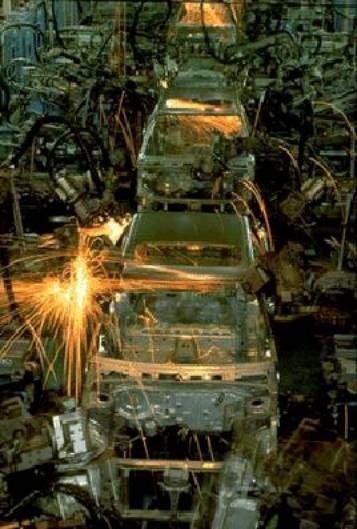U.S. automakers continued to narrow the productivity gap between them and Japanese manufacturers last year, with DaimlerChrysler AG's Chrysler Group making the biggest strides, the authors of a closely watched study said Thursday.
Meanwhile, the assembly plant designated the most productive of 2005 by the Harbour Report, is one that is scheduled to close: Ford Motor Co.'s facility near Atlanta.
The annual study, which compares labor productivity at six companies with North American plants and is published by Troy-based Harbour Consulting, put Nissan Motor Co. in the lead with an average of 28.5 hours per vehicle. Ford trailed the list at 35.8 hours.
"The relative ranking of the six largest automakers is likely to change in the next couple of years, and the leaders could be anyone," Ron Harbour, president of Harbour Consulting, said in a statement.
Harbour said Nissan's productivity lead amounts to a cost advantage of $300 to $450 per vehicle over less productive manufacturers.
The domestic Big Three have been steadily catching up to Japanese automakers. The difference between the most productive and the least productive has narrowed from 16.6 hours in 1998 to 7.3 in 2005.
Japan's Toyota Motor Corp., which took first place in 2004, came in second at 29.4 hours, followed by Honda Motor Co. at 32.5 hours. General Motors Corp. was close behind at 33.2 hours, followed by Chrysler at 33.7 hours.
The report, first published in 1989, measures productivity at assembly, stamping and engine and transmission plants. It calculates the number of hours worked by salaried and hourly employees at a plant and divides that by the number of units produced.
Among assembly plants, the Ford facility outside Atlanta stood out with 15.4 hours per vehicle. The plant is one of seven Ford announced it is closing by 2008 as part of its restructuring.
"Ford Atlanta has had one of the best work forces of any assembly plant in the industry and the data proves that," Harbour said. "The decision to close the plant had nothing to do with the dedication of the people, from whom Ford has learned many competitive practices over the years."
Despite the narrowing productivity gap, the automakers remain far apart by other measures, the study's authors noted. Capacity utilization hovered at around 100 percent for Toyota, Nissan and Chrysler, while Ford's assembly plants ran at 79 percent of their potential output.
Another big difference is profitability. Nissan, Toyota and Honda each earned more than $1,200 before taxes on every vehicle they sold in North America in 2005. In contrast, Chrysler Group earned $223, while Ford lost $590 and GM lost $2,496 on each vehicle. This reflects differences in health care and pension costs, as well as rebates and low-interest financing used to cut inventories, the report said.

